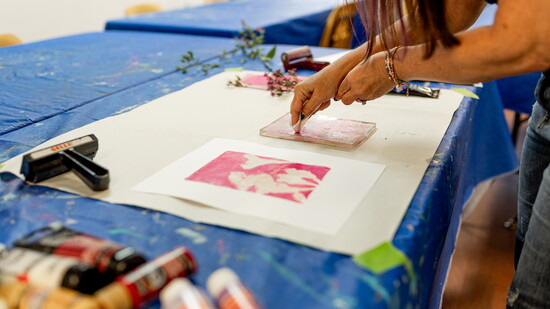Some people find art—for Mary Shadbolt, it found her. Long before she knew where it would take her, she was already creating (a pen and paintbrush often her favorite companions). But it wasn’t until years later that she discovered her true canvas: the art classroom. Now the owner of a vibrant art school on Main Street in Denville, Mary brings her passion full circle, inspiring others to tap into their creativity.
“I always knew I was going to be an artist,” says Shadbolt, “I came out of the womb that way, creating and freelancing for decades, but the more I taught, the more I realized that teaching is what I need to complete me,” she recalled. “Art is an invaluable tool. No matter what people manufacture or design, it all begins with a drawing, from houses and cars, to fashion, and even storyboarding a movie. That's how I relate my lessons to art career awareness.”
As a graduate of both Rowan University, in NJ and Moore’s College of Art and Design in Philadelphia, she earned her BFA in Illustration and Master’s in Art Education with K-12 Certification in Art Education. Shadbolt now works with a variety of students—age 7 through adult.
During the school year, enrollment typically hovers anywhere between 85 and 90, or even 120 students. Mary follows the blueprint she developed while writing the art curriculum for the Paramus school district, where she taught art for several years, incorporating art techniques, art history, art demonstrations and cross-curricular connections.
At the center of her teaching philosophy is DBAE, or Discipline Based Art Education—a standard in some public schools whereby art teachers work with all disciplines, including history, literature, and science, to tie in projects to the lessons taught there.
Today, students can enroll in a variety of courses, art workshops during the school year, and camps in the summer. Shadbolt keeps up with changes in art education by taking professional development classes, attending workshops, and staying in touch with other art teachers.
Shadbolt's summer camps explore themed weeks with hands-on experience in drawing, painting, sculpture, collage, and more, offering an opportunity to explore a multitude of art techniques.
Some of the art school’s yearly courses include a five or 10-week adult drawing class, five or 10 week studio art class for age 11-18, and painting club for ages 8-14,. All are offered September-June, and range from 60 to 90 minutes long.
According to Shadbolt, students aged seven through 11 are her largest population—which is wonderful as it’s around this age, she explains, that they start to truly grasp artistic concepts. “While all children draw and paint at a young age, once students reach the age of 7, they understand more multi-step processes and they can make cross-curricular connections as well.”
“I like to meet my students where they are,” Shadbolt said. “Starting with providing them with a safe and welcoming environment. Students are to incorporate the materials and principles discussed, but are free to approach the assignment with their own personal style.”
“They are learning about themselves, the world around them, as well as the child (or adult student) next to them,” she added.
“My daughter loves taking classes with Mary,” said Rachel M. in a testimonial on Shadbolt’s website. “She really enjoys the projects and is very proud of her work. Mary is very encouraging of all the kids and is a great confidence booster.”
Shadbolt emphasizes that one of the keys to successful art education is helping students appreciate the importance of the process, as well as the finished piece. Just as an athlete trains for a game and then showcases their skills on the field or court, students at her school understand that courses end with an exhibit of their work in an art show, which Shadbolt organizes throughout the year.
“It’s important for students to celebrate their successes and discuss their work using their new knowledge with friends and family. This experience is vital for growth in all of my students, age 7 through adult!” Shadbolt explained.
Her average class size is between 5 and 12 students so Shadbolt can provide individualized instruction by monitoring her students’ work and providing continuous feedback.
A newly added workshop pairs Shadbolt with an adult student who is also a retired special education teacher. Together, they’ll lead a class for students with special needs—a first for the school, and one Shadbolt hopes will become a lasting addition to her offerings."
“This is sort of a new incarnation for me,” Shadbolt says.
No other local studios, she says, offer a class for special needs students, so she sees it as filling that void.
“Students could come to this class with neurological issues, ASD, or perhaps they are non-verbal. Regardless, art should be available to all.”
To explore local art education opportunities with Shadbolt, visit artclasswithmary.com.
“They are learning about themselves, the world around them, as well as the child (or adult student) next to them."
